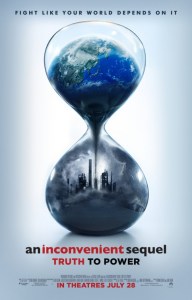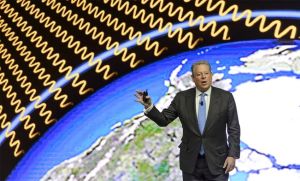An Inconvenient Sequel: Truth To Power (2017)


SHOULD I SEE IT?
YES
Though there are some stunning visuals and gut-punching information, An Inconvenient Sequel is less lecture, and a more personable film.
Gore comes across as alternately tired and hopeful, frustrated but optimistic in where things are headed. His inner resolve is hard to not admire.
If you believe that we are in a climate crisis, or that climate change is something we can start to reverse and turn the tide on, An Inconvenient Sequel will give you a lot to think about and be hopeful about.
NO
Those who do not believe in climate change or believe Al Gore is something of a snake oil salesman, will not find anything here to change their mind.
Detractors have already bashed the film for masking over Gore’s personal connections to SolarCity, the aforementioned Indian negotiations, and find him something of a hawkish televangelist. I mean, if you feel that way, you’re not watching this anyway, right?
Does little to bridge gaps with a deeply divided electorate.
OUR REVIEW
In 2006’s two-time, Oscar-winning documentary An Inconvenient Truth, director Davis Guggenheim achieved three significant things: 1) He showcased former Vice-President Al Gore’s research on climate change, following him around on a series of presentations which illustrated how dire the Earth’s shifting climate conditions could alter lives forever. 2) He provided us insight into Gore himself, a man, in some ways, still reeling and trying to regain his footing from losing the 2000 presidential election by, essentially, 537 votes. And 3) he offered Gore a platform to discuss what people could do to help reverse the tide and work towards saving the planet.
In what served as a wake-up call in a rather admittedly bleak documentary, a hopeful tone is captured, with a message that all is not lost, but we must immediately get to work on making things better.
11 years later, Gore returns to the national spotlight with An Inconvenient Sequel: Truth to Power, co-produced by Guggenheim, and directed by Bonni Cohen and Jon Shenk. Initially, my first exposure to this film came when the trailer for this was shown before The Mummy, of all things, and most of the audience groaned and mocked the film. With President Donald Trump trolling around in the White House, I found that an interesting response.
A lot of real estate has literally eroded from 2006 to 2017, and when the current President of the United States is on record claiming that climate change is a hoax, and fighting it is a waste of important resources, and a significant number of Republicans publicly echo those beliefs, it starts to make sense why half of America finds this film a propaganda piece on par with how Democrats view the “films” of Dinesh D’Souza.
And yet, a Pew Research Poll conducted in 2016 found 79% of respondents believe that climate change is occurring, with nearly 50% believing it is man-made. People forget that An Inconvenient Truth was a significant box office draw in 2006, making Democrats and Republicans alike pause and consider the information presented in the film.
At nearly 70 years of age, Gore has aged noticeably in the last decade or so, still grappling with feeling intermittently encouraged and defeated in his public fight on climate change.
Cohen and Shenk assume their audience has some existing knowledge of the climate crisis and, as a result, they are able to get right into the heart of things. Gore has never stopped presenting his slideshow around the world, lecturing at numerous conferences and seminars. We learn more about the climate training courses he began teaching back in 2005. In Florida, we see Gore standing and wading through floodwaters bustling down once busy streets, fish swimming past him, as he talks to a Florida mayor about the challenges the state currently faces in combating erratic weather changes. The lack of agreement and responsiveness from government officials has eroded the community, the state, and entrenched Florida in a bitter partisan war of words.
One terrific sequence comes when Gore travels to Georgetown, Texas, the reddest town in the reddest county in the reddest part of the state. He finds kinship with Republican mayor and Trump supporter, Dale Ross, who discovered that investing in solar technology and innovation would cause a significant savings for the residents of the town. And so, Georgetown, Texas is going to be utilizing 100% renewable energy in a few short years.
The centerpiece of the film involves Gore’s attendance at the 2015 United Nations Climate Change Conference in Paris, France. An interesting dichotomy emerges as Gore begins talking with representatives from India, who have a number of other challenges before them, meaning their adopting and adhering to the Paris Climate Agreement is difficult and untenable. We see a chasm appear between what climate change protocols and innovation means for “developed” and “non-developed” countries. Though he jokes that he is a “recovering politician”, Gore slips into his political skin and begins trying to broker a deal between a solar energy company, SolarCity, co-founded by Elon Musk, and representatives from the Indian government.

o spoilers here, but let’s just say that everyone signs the Accords. And in full disclosure, the Energy Minister of India, Piyush Goyal, now claims that Gore overstates and misrepresents his work in getting India to the signing table, as depicted in the film.
We do see some updates to his presentation, but largely we are back revisiting a man who has never wavered in pushing for something he believes in. Critics are abundant both on screen and off.
Gore jets around the world but claims he’s environmentally conscious. Gore is unwilling to listen to dissenting opinions or acknowledge that we have not had the “planetary emergency” he warned about in the 2006 film. Gore is a modern-day Don Quixote and climate change are his windmills, pun probably intended, and so on and so on.
Supporters and detractors alike can agree on this: Gore is now a man married to a cause and his convictions. For those who felt he came across too beloved and idolized in the first film, Gore feels more relatable here. And he preaches an evangelism of hope and “winning this fight”, even when our existing President has undermined, in a just a few months, the years of bipartisan support and progress Gore has fought to obtain every step of the way.
An Inconvenient Sequel will not have the jaw-dropping impact the previous film did. If you are someone who finds his work to be empty, foolish, and little more than narcissism, then this sequel is not so much inconvenient as it is inconsequential.
For everyone else, the film offers plenty of information and food for thought, perhaps in a more realistic, mannered tone. Gore acknowledges frustration, distress, and uncertainty with what the future holds. By the end, things still seem daunting perhaps, but not so insurmountable.
Maybe, just maybe, there is still a chance.
CAST & CREW
Documentary Featuring: Al Gore.
Director: Bonni Cohen, Jon Shenk
Actual Films, Participant Media, and Paramount Pictures..
